Maybe spoilers?
Director: Stanley Donen & Gene Kelly
Screenplay: Adolph Green and Betty Comden
Starring: Gene Kelly, Donald O'Connor, Debbie Reynolds, Jean Hagen, Millard Mitchell, and Cyd Charisse
Images from the 2002 WHV 2-disc SE
Singin' in the Rain is the perfect musical, and while it's a superlative that's been beaten to death, it's no less true. The movie is not just a textbook example of what a musical does best, it is the textbook. Musicals, by their very nature, are expressionistic. The very best work because they divorce themselves from reality, since breaking out into song naturally involves smashing the confines of inhibition. The silent/sound era is therefore, an arena ripe for Singin' in the Rain to be set, since there have been few bigger changes to convention than the advent of sound.
Á la Sunset Blvd.
Singin' in the Rain is the Sunset Blvd. of musicals, in part because both films are exposés of Hollywood and cut straight to the bone. Whereas Sunset Blvd. focused on the destructive nature of show business, Singin' in the Rain aims at falsehood and the illusion that movies present. The first 10 minutes rapidly fire one satirical jab after another, and it's amazing how unchanged the world of celebrity worship is after more than 50 years. There were fan magazines way back then:
If these seem tame by today's standards, that's understandable. Nevertheless, it's truer than ever that the media forges farcical relationships/feuds in the eyes of the masses, and they are often built off of the screen personas and the roles actors play. The suggestible power of the movies was perhaps greater back then, when the media tended to elevate their subjects rather than drag them through the mud like today. There was more mystique about the celebrity that made them seem supernatural, whereas nowadays, we instantly get Youtube videos of celebrities walking barefoot out of a gasoline station restroom.
What makes Singin' in the Rain so much fun is that it knows the difference between illusion and reality and invitingly lets us in on the joke. Don Lockwood's speech is so funny in a way that only cinema could do it. Literature cannot successfully create the sort of contradiction that's presented. Here we have Don Lockwood and Lina Lamont, the two living screen legends at the premiere of another one of their silent romances:
On the red carpet, they look every bit of movie star they're playing, and Don prevents Lina from speaking (with a voice like nails on a chalkboard) by giving a lengthy speech on how Dignity has shaped his career. Virtually everything we see clashes with what he says, from Don and Cosmo's vaudeville acts, to Don's roles as a stuntman, to his relationship with Lina, and the "sunny" weather in California. Lina (boldly played by Jean Hagen) is brimming with vanity and is amusingly convinced by the fan magazines that she and Don are indeed an item. I love that line Don tells her:
"There's nothing between us... just air."
1951 nostalgia for the 1920s
Musical comedies are like siblings to the screwball comedy (Some Like it Hot, for instance, does have a few musical numbers), and they are generally aware of their own silliness. The "Fit as a Fiddle" number has Don and Cosmo with a goofy grin on their face:
It's silly, yes, but the acrobatics the two pull off is astounding. It's as if the only way to get that good is to not take yourself seriously. The heart of Singin' in the Rain lies in its own self-deprecation of sorts. The red carpet announcer for instance, says the countess and her husband have been "married for two months but are still as happy as newlyweds." Here's the countess:
If this seems parodic, part of it may be that Singin' in the Rain is a retrospective of the late 1920s and as such, draws caricatures of the people from there. Mind you, this is the same countess who calls the talking picture: "vulgar." As a throwback to the 1920s, the film also has fun with the technical aspects of the transition to sound. Complete with the sound getting out of sync, we also realize how silly pantomime looks when coupled with sound:
What becomes apparent through these scenes is how cobbled together a movie really is. The separate elements can be teased apart, mixed together, and pretty soon, we have actors speaking in voices that aren't even theirs. And yet, when done properly (and on purpose), it all comes together beautifully through the editing. It's only when the unveiled illusions are exposed unintentionally that you realize how absurd a movie really is. I recently saw a work-print version of X-Men Origins: Wolverine, which still had CGI models lacking their skins, so they were obviously fake. Becoming aware that you're watching a movie is not always a bad thing (If....), but when the intention is to convince the audience of a reality and this becomes exposed, the film becomes a laughing stock. I find this happens more with films that take themselves seriously, which is perhaps why musicals tend to be both parodic and self-aware.
Self-awareness and Breaking Inhibition
Singin' in the Rain reaches one of its many zeniths of self-awareness during the "You Were Meant for Me" number. What remains so fascinating about this particular scene, for me, is that the fictional emotion is real while still being fictional. In this scene, Don is admitting his love for Kathy, and rejecting the falsity of the Lockwood & Lamont relationship. In this sense, the emotion he feels for Kathy is "real" and the emotion he feels on screen (on our screen) for Lina is just acting:
Yet when we consider the working relationship between Gene Kelly and Debbie Reynolds, this adds another layer of illusion to the picture. Apparently, Gene Kelly disparaged Debbie Reynold's dancing abilities, and was considered somewhat tyrannical on set. That none of this is apparent in the final product mirrors that hilarious scene where Don and Lina are filming a silent scene. During that scene, Don verbally jousts with Lina while romantically wooing her on film:
"Donnie, you couldn't kiss me like that without meaning it."
"Meet the greatest actor in the world. I'd rather kiss a tarantula."
That the "You Were Meant for Me" number takes place on a stage, with filming equipment and all, seems to be pointedly emphasizing the notion that this is just make believe. It's also interesting to note that the scene begins, and ends with them separated by the ladder. This also hints at a wariness on their parts, perhaps uncertain of their newfound emotions.
I wouldn't say Gene Kelly or Debbie Reynolds are the greatest actors in the world, but the fact that they convey genuine feelings on screen regardless of their working relationship shows just how influential the illusion of cinema can be. Part of this that works so well stems from giddy persona that Gene, Debbie, and Donald put forth. There's a glee that's almost parodic and sort of like the Astaire and Rogers musicals. They knew they were good, and they didn't mind making fun of themselves for it:
The twin centerpieces of the film, the "Good Morning" and "Singin' in the Rain" numbers are the epitomes of joy, and their energy comes from that overwhelming sense of happiness. For me, the other numbers ("Moses Supposes," "Fit as a Fiddle," "Make 'Em Laugh") have an obvious parodic quality that these two numbers seem to lack. "Good Morning" is arguably my favorite, simply because it's the whole gang just letting loose and doing what they do best. But the title number is rightfully the most iconic.
The number embodies what musicals do best: break free of inhibition in an expressionistic manner. The umbrella is a wonderful symbol of that inhibition, as he first plays with it while getting soaked, then frees himself from it entirely and allows his true emotions to wash over him. If the "You Were Meant for Me" number has a hint of uncertainty, by the time "Singin' in the Rain" comes around, Don is convinced of his genuine love. The former number perhaps has a degree of wariness, whereas the latter is filled with total conviction.
Like many musicals, Singin' in the Rain allows the audience to be "in" on the joke. That is, the audience knows that musicals are far from reality and it shouldn't really matter. It's the idea of breaking barriers that's important to musicals like Singin' in the Rain. In fact, there's a lot of "wall breaking":
Whether it be the 4th wall when Don slyly tells how lonely movie stars really are:
Or the set wall during "Make 'Em Laugh":
This number is difficult to represent with a single screenshot, since a still photo invariably removes the kinetics that Donald O'Connor had, so it's best to just watch the movie. The number proves how meaning can be had in even the zaniest of scenes. For me, I see this as a question of the value of art over entertainment, and Cosmo completely laughs at how it's generally seen as either one or the other:
"And you can charm the critics and have nothin' to eat
Just slip on a banana peel The world's at your feet"
It's almost as if the film's saying: you can make art or entertainment, but you can't make both. But with that, the film disproved its own argument, because it's definitely a wonderful piece of art that's sublimely entertaining. Nevertheless, there is some truth that entertainment and art aren't always hand in hand.
Other wall breaking, such as the old burlesque pie-in-the-face bit, this time on a big movie star instead of a clown (or maybe the two are one and the same?):
There is also the wonderful "Moses Supposes":
Again, there's that parodic demeanor of poking fun at the serious. The sheer bravura of Gene Kelly and Donald O'Connor is one of my favorite things about them, in part because they defuse any smugness with glee. Talent like that, well it must be taken lightly by them.
The Cyd Charisse Numbers
Well, since it's almost been a year since Cyd Charisse passed away, I felt like giving some more attention to the wonderful "Broadway Ballet" number she's so prominent it. Her elegance gives a kind of class that the tap dancing numbers may be limited by. This section of the film is really a film within a film, and at first, it seems to have nothing to do with the main storyline, but thinking about it makes me feel it is possibly representative of the temptations encountered in Hollywood.
We first see her in a smokey (yet totally staged) café, and the first shot is of her shapely, long leg, at the end of which is perched Gene Kelly's hat. It's a seductive, intoxicating dance, and on a completely different level than the innocent numbers like "You Were Meant for Me." Of course, she is wearing emerald green, the color of envy. After this brief flirtation, Gene Kelly is whisked away by his agent and becomes a big broadway star. Eventually, he meets her again at a party, only this time, she is clad in white. They imagine dancing together in their minds set against a background in limbo.
The choreography of this scene is simple, yet beautiful. She is almost the femme fatale of the number, having seduced him before in her green dress. Here, he again succumbs to her charms and the two become wrapped together in the incredibly long silk of her dress. Eventually, they must part, because he realizes there can be no real future with a gangster's mistress. Their meeting is strangely ambiguous, and I can't decide whether I should be rooting for them or not. It's the same feeling I get from watching Jeff Bailey and Kathy Moffat in Out of the Past. At times, I too, succumbed to her charms and wanted Jeff to be with her.
Singin' in the Rain: A movie about itself
In addition to being the Sunset Blvd. of musicals, I would posit the film is also the 8 1/2 of musicals as well. Not only does it expose the ins and outs of Hollywood, it also explores the nature of film itself. The sham Lockwood & Lamont movie persona, contrasted with the genuine one between Don and Kathy comes very close to the screen personas of Astaire and Rogers and their real relationships. This division between reality and movie-illusion culminates in the final scene:
The curtain, of course, represents the silver screen itself. There is the screen persona (Lina) and the person behind that image (Kathy). It's fitting that in a musical, where barriers are constantly broken, the curtain finally be pulled to expose the truth:
And I must commend Jean Hagen, who probably has the boldest role in the movie. Her role is probably the single most fun, and her Oscar nod was well deserved. An interesting thing I just learned was that her "dubbing" by Kathy is actually her own normal voice, which kind of adds an extra twist to the whole persona thing.
Singin' in the Rain is very much a movie with itself as its subject, just like 8 1/2, although I prefer the musical, personally. The film, I think, has been echoed in Robert Altman's The Player, which also ends with referencing the title of the movie you've just seen:
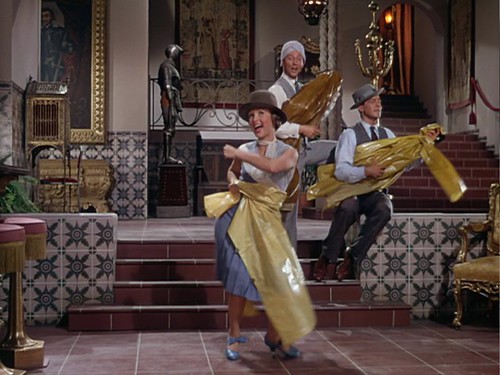
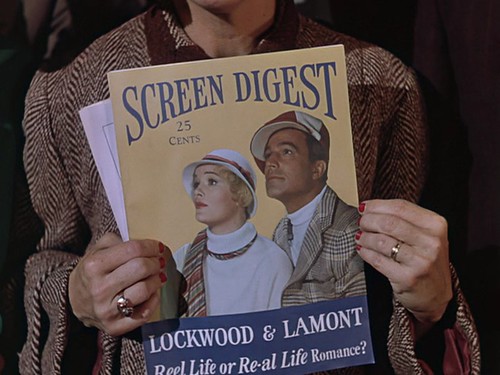
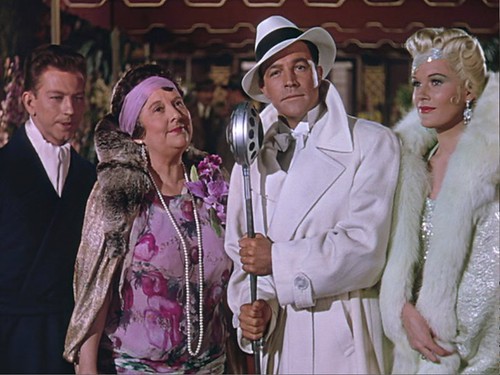
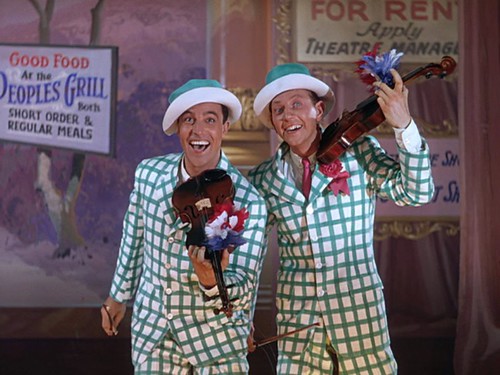
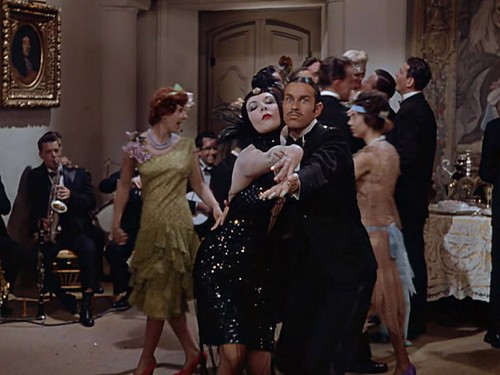
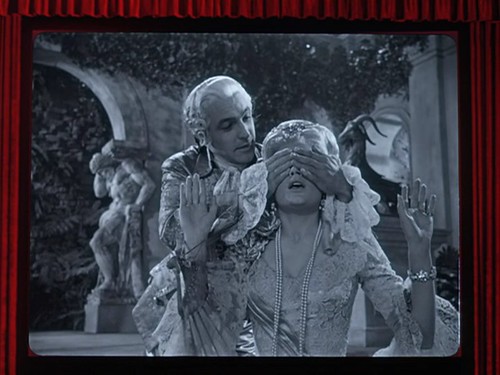

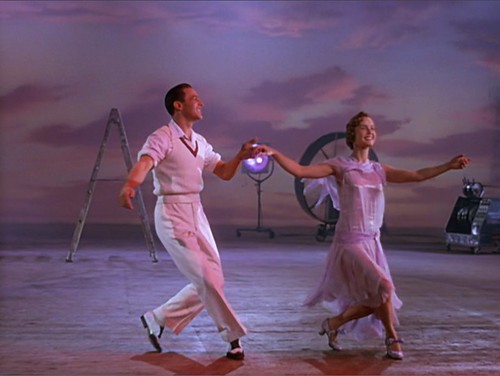
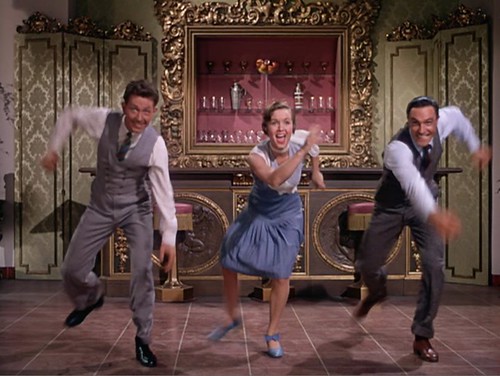
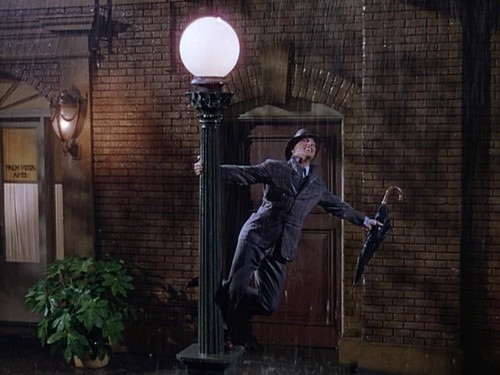
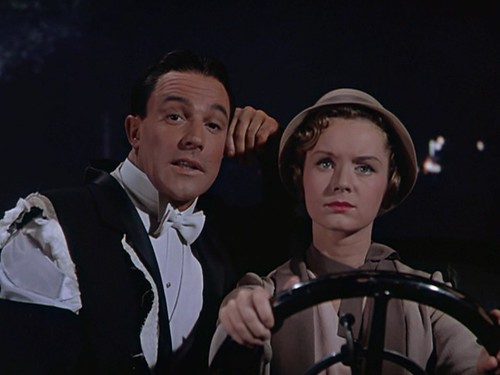

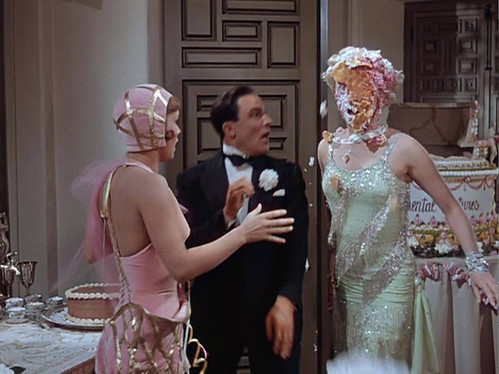
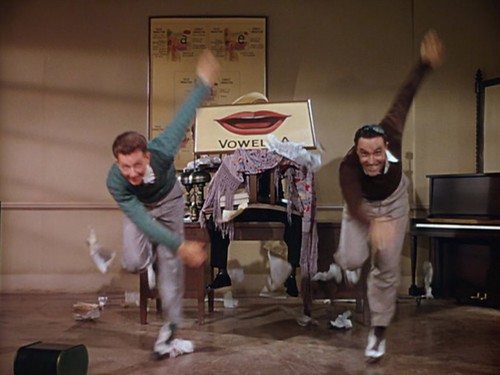
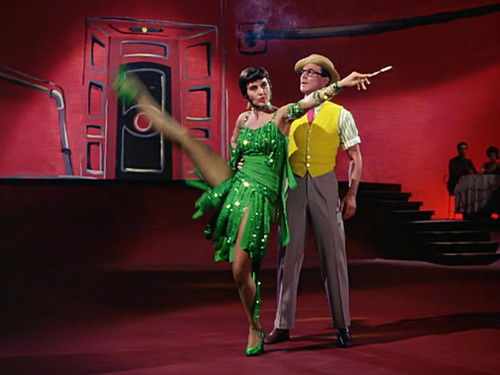
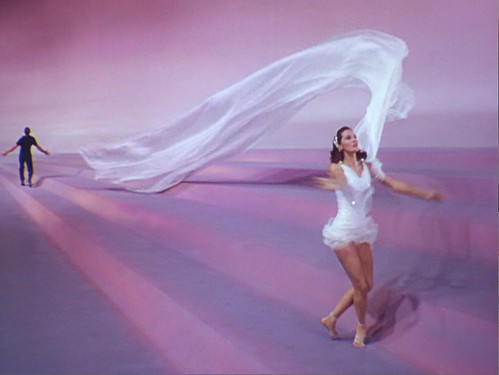
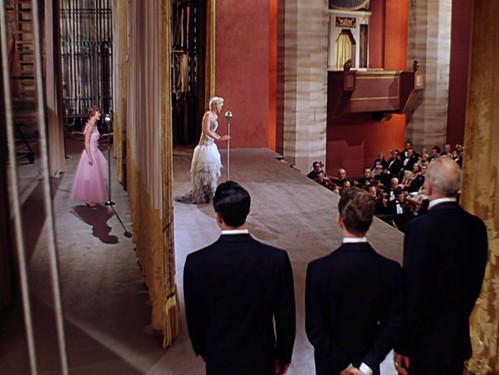
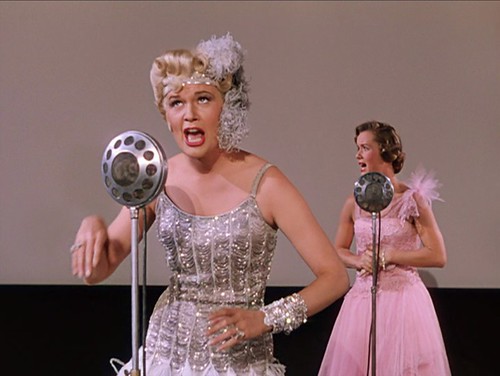
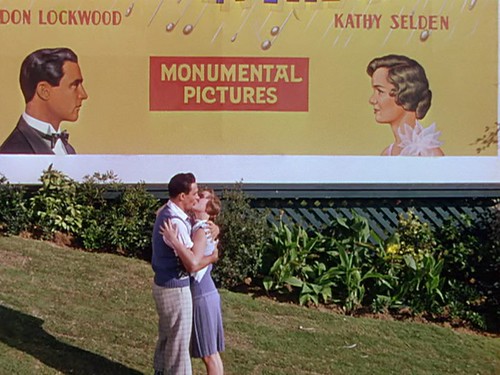
i have never read a article like this about my favourite movie ever.
ReplyDeletelovely article, for a lovely movie, thank you for an fascinating read.
Good article about the best film ever made!
ReplyDeletei love your Pictures of the Movie of Singing in the Rain i love their Songs and their Dances !!!! and i also think that how they made that Movie is the best Movie ever made in 1927 's that was a well made movie they did a good job with all of the songs and dances that was well made !!!!!
ReplyDeleteVery enjoyable article and love the pics -thanks!
ReplyDeletelove your article...!
ReplyDeleteactually was checking out some info on the greatest movie ever as I was going to see it yesterday evening on big screen... was the first time and... OH MY GOD!!!! almost 60 years after MAGIC IS DEFINITELY STILL THERE!
thank you
cheers from brussels
LoLo